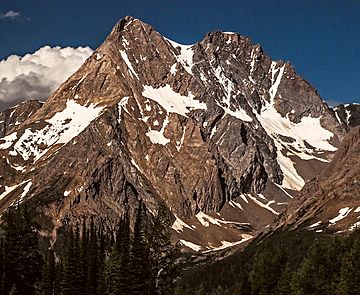Jumbo Mountain (Canada) facts for kids
Quick facts for kids Jumbo Mountain |
|
|---|---|

Karnak-Jumbo Massif, southwest aspect.
Karnak (left), Jumbo (right) |
|
| Highest point | |
| Elevation | 3,437 m (11,276 ft) |
| Prominence | 752 m (2,467 ft) |
| Parent peak | Jumbo Mountain (3437 m) |
| Geography | |
| Location | British Columbia, Canada |
| Parent range | Purcell Mountains Columbia Mountains |
| Topo map | NTS 82K/7 |
| Climbing | |
| First ascent | 1915 |
Jumbo Mountain, also known as Mount Jumbo, is a tall mountain peak in British Columbia, Canada. It stands 3,437 meters (11,276 feet) high. You can find it about 42 kilometers (26 miles) west-southwest of a town called Invermere. Jumbo Mountain is part of the Purcell Mountains.
This mountain is very close to another peak called Karnak Mountain, which is only about 0.79 kilometers (0.49 miles) away. Jumbo and Karnak together form a large mountain mass called a massif. This massif is the second-highest mountain in the Purcell Mountains and the fourth-highest in the larger Columbia Mountains range. The highest peak nearby is Mount Farnham, located about 11 kilometers (6.8 miles) to the north-northeast.
Contents
Discovering Jumbo Mountain
The first time people successfully climbed to the top of Jumbo Mountain was on August 4, 1915. A group of climbers, including H.O. Frind, A.H. & E.L. MacCarthy, M & W.E. Stone, B. Shultz, and the famous guide Conrad Kain, made this first ascent. They climbed the North/Northeast Slopes of the mountain.
How Jumbo Mountain Got Its Name
The mountain was named by Edward Warren Harnden. He named it after the "Jumbo Mineral Claim" from 1892, which was a mining claim on a nearby stream called Toby Creek. The mining claim itself was named after Jumbo the elephant, a very famous elephant from the 1800s. The name "Jumbo Mountain" was officially approved on March 31, 1924, by the Geographical Names Board of Canada.
Weather and Water Around Jumbo Mountain
Jumbo Mountain is in a subarctic climate zone. This means it has very cold, snowy winters and mild summers. Temperatures can drop below −20 °C (−4 °F), and with the wind, it can feel even colder, sometimes below −30 °C (−22 °F).
Water from the mountain flows in different directions. Rain and melting snow from the south side of Jumbo Mountain drain into Jumbo Creek. This creek then flows into Toby Creek. On the north side, the Jumbo Glacier melts, and its water flows into Horsethief Creek. Both Toby Creek and Horsethief Creek are tributaries of the large Columbia River.
Climbing Routes on Jumbo Mountain
There are a few known ways to climb Jumbo Mountain:
- North/Northeast Slopes: This was the route used for the first climb in 1915.
- West Ridge: This route was first climbed in 1974.
See also
 In Spanish: Monte Jumbo para niños
In Spanish: Monte Jumbo para niños



